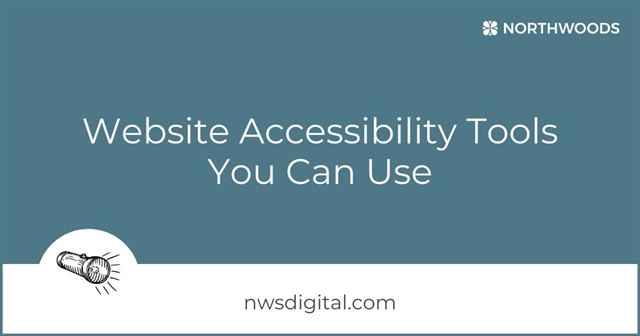By Sydney Shimko
February 16, 2024
3 Minute Read
Updated: Feb. 16, 2024: Aug. 23, 2023; April 4, 2022
Originally Published: May 11, 2021
Many accessibility tools and products on the market “bolt on” to your website as third-party scripts or plugins. These overlay tools claim to make websites more accessible to end users and/or protect site owners from accessibility lawsuits.
Many of these products use JavaScript to detect and attempt to correct problems or enhance accessibility by manipulating your website’s front-end code. Some products extend presentation controls to end users, so they can customize, for example, contrast and font size.
These bolt-ons also address (or claim to address) accessibility issues related to:
- writing and adding alternative text for images,
- keyboard control,
- and improving field labels, error handling, and focus control on forms.
Sounds like a great, easy fix, right? Not so fast.
Overlay Tools, Underwhelming Results
A WebAIM Survey of Web Accessibility Practitioners found that “A strong majority (67%) of respondents rate these tools as not at all or not very effective. Respondents with disabilities were even less favorable, with 72% rating them not at all or not very effective and only 2.4% rating them as very effective.”
When end users are frustrated, site owners should beware. The companies that make these tools often promise site owners immediate compliance with laws and standards. Not necessarily.
Automation is not a reliable approach to accessibility. To make matters worse, installation of automated overlay tools – and the page reconfigurations they execute – can slow down page loading and impair functionality of common assistive technology that supports users. Consider also:
- According to accessibility expert Adrian Roselli: “We have found that in some instances, implementing an overlay makes it more difficult for a blind person to use a website. There have even been allegations that some overlays, rather than making the website accessible, actually interfere with automated testing tools, providing false positives for websites that are really inaccessible. This means that the website will have the appearance of being accessible without necessarily meeting accessibility standards.” (Read more about the negative effects of accessibility overlays and watch a video by a visually disabled website user explaining her experience with them.)
- Some overlay tools set cookies on users’ computers. These cookies automatically track user settings and cause the overlay configurations to persist as users travel from site to site. Failure to offer users an explicit opt-in to this tracking could put your company at risk of GDPR and CCPA infringements.
- If your business serves customers in Europe, be advised that the European Commission has published a statement making it clear that overlays aren't an acceptable path to WCAG compliance. And in 2023, the European Disability Forum and the International Association of Accessibility Professionals came together to issue a statement against the use of overlays. (Note that the EU's European Accessibility Act will take effect in Spring 2025 and requires US companies operating in EU countries to meet WCAG 2.1 AA standards.)
Automated tools, then, are not the panacea they purport to be. Even if they worked as advertised, much of their functionality would be redundant given the array of readily available tools that assist users comprehensively across the web.
Major web browsers offer native controls or extensions for presentation characteristics, including font size, zoom, and color contrast. Users with or without disabilities choose to employ these controls to navigate the web in ways that best suit their personal preferences. Additionally, users can employ such assistive technology devices as screen readers, screen magnification software, alternative input devices, voice recognition software, and such adaptive strategies as mouse speed selection.
Ideally, your website integrates well with common browser functions and assistive tools and practices. This is a matter of leveraging semantic HTML and following Web Accessibility standards and best practices.
The folks at overlayfactsheet.com sum up the effect of web overlays well: “… it is a mistake to believe that the features provided by the overlay widget will be of much use by end users because if those features were necessary to use the website, they'd be needed for all websites that the user interacts with. Instead, the widget is – at best – redundant functionality with what the user already has.”
Engage an Accessibility Expert to Identity and Remediate Issues
Much of the web remains inaccessible to many users. An automated accessibility analysis of the home pages for the top million websites in 2021 showed 97.4% of home pages had detectable failures against the Web Content Accessibility Guidelines (WCAG) 2.1 Standard. The failure number for 2020 was 98.1%.
We at Northwoods think that level of progress is too slow. That’s why we’ve built a strong accessibility practice within our web design and development company. While some automated overlay tools can suffice as a temporary patch for certain problems, we find they are insufficient, can make things worse for users, and can be very costly in the long term.
As the International Association of Accessibility Professionals (IAAP), states: “IAAP believes that Overlays, plugins, or widgets must never impede access to users’ assistive technology, choice of browsers and/or operating system features. IAAP therefore does not support members making false claims about any products or services which could be harmful, either directly or indirectly, to end-users, including people with disabilities, or the integrity of the accessibility profession. More specifically, in relation to Overlay technologies, at this time companies should refrain from using marketing language implying that a website or application can be made fully accessible to all people with disabilities by simply installing a plugin or widget without requiring additional steps or services.”
This is why the best way to correct and enhance accessibility is to bring in an expert in the field. An expert can audit and evaluate the current level of a site’s accessibility, discover and report errors, and develop a roadmap to remediation that prioritizes repairs by scope and impact.
Accessibility is serious business – and it's good business. It pays to take it seriously.
Additional Reading
If you’re concerned about website accessibility and aren’t sure what steps to take, don’t hesitate to contact us. Our accessibility experts are happy to help!
Related Blog Posts

Despite documented disability numbers, growing lawsuits, established and mature accessibility guidelines, and even Federal accessibility requirements for certain businesses that receive government funds, most companies continue to ignore web accessibility – to their peril. Don't be one of them!

Although automated website accessibility testing tools can't replace human judgment, there are several that are helpful in performing an initial accessibility audit. Here are some of the ones we recommend.

Adherence to website accessibility standards can improve usability for everyone, enhance user experience, build brand loyalty and encourage conversions. Read on to make your WordPress website accessible and ADA Section 508 compliant.